GENERALITES SUR LES MANIPULATEURS A VENTOUSES À LEVIER
The RELDA suction lifters designed and manufactured by ADLER SAS - or selected by ADLER SAS under the ADLER SELECTION brand - are regularly subjected to load and leak tests. The average forces obtained by these tests are approximately 2 times greater than the maximum operating loads indicated.
The safety factor is thus 2, i.e. more than the coefficient of 1.5 required by Directive 2006/42/EC § 4.1.2.3 for manually-operated machinery and lifting accessories. See Appendix.
1. FIELD OF USE
Suction lifters are designed to lift, transport and maintain all objects having a smooth and gas-tight (non porous) surface.
Any other use is strictly prohibited.
2. OPERATING INSTRUCTIONS
By definition, suction lifters are hand tools and must not be used in conjunction with cranes or any other lifting devices.
For safe use, the following guidelines must be observed:
• The suction lifter must only be used once the operator understands its operation or with the assistance of someone experienced in its use.
• Do not lift loads in excess of the maximum load specified for a given direction of pull. The lifting forces indicated in the ADLER catalogue are valid based on optimal fastening of the suction lifter for a traction force perpendicular to the surface, on a smooth, clean and dry, glass surface, with new suction cups in perfect condition, at ambient temperature of 20 °C and an atmospheric pressure of 1013 mbar. When glass panes are transported vertically (lifting force parallel to the surface), the maximum load capacity indicated in the catalogue must be divided by 2.
• The carrying capacity may be significantly reduced or even completely lost due to ageing or damaged rubber suction pads, low temperatures, humidity or poor surface conditions. The suction lifters may be unusable with certain materials such as textured glass, stone or unpolished metals, etc.
• The lifting capacity decreases proportionally with the atmospheric pressure and thus depends on the altitude of operation in relation to sea level. This should thus be taken into account at higher altitudes!
• The condition of the suction lifter should be checked prior to each use. Use straps to secure objects to be carried by the suction lifter, for example.
• The vacuum created exerts a pulling force on the surface of the object. This force may increase even further during use. It is the user's responsibility to ensure that this phenomenon cannot damage the product handled. This can happen for example if the glass pane is too thin. It can deform and break.
Comment
The suction pads are made of high-adhesion natural rubber. After the initial applications or after having remained attached for a long period of time, suction lifters can leave black marks on the object they were attached to. Such marks can be easily removed with alcohol. However, an initial test should be made by applying a small amount of alcohol to a non-visible location to determine the material's reaction.
3. HANDLING
Always check that the suction lifter is in proper operating condition prior to each use.
Particular attention should be paid to the condition of the rubber pad. It must show no signs of damage or cracking.
Prior to each use, always check the rubber pad for possible operational limitation due to reduced elasticity, e.g. resulting from ageing, wear or inappropriate maintenance/drying. Immediately replace any rubber pads that are damaged or exhibiting reduced holding capacity.
The suction surface and the rubber pad must be clean, dry and free of oil/grease. The holding force of the suction lifter is significantly reduced on uneven, rough and porous surfaces, up to the point where the holding force may be totally lost. Dirt accumulation can damage the surface, the rubber pad and possibly even the pump mechanism.
4. SUCTION
Press the suction lifter firmly against the suction surface. The rubber pads must be relaxed and be placed flat on the surface.
|
|
Lever-action suction lifters
|
The vacuum is generated by pushing back the levers (or by bringing together the 2 parts of the handle in the case of an eccentric suction cup, reserved for tabletop or conveyor handling operations). A resistance created by the vacuum must be clearly perceptible. Otherwise, repeat the operation while pressing each pad onto the surface more efficiently. |
|
Pump-action suction lifters |
• The vacuum is obtained after repeatedly actuating the pump's plunger.
•
These types of lifters all have an indicator ring on the plunger: the vacuum is sufficient when the ring is no longer visible; as soon as the ring reappears, the vacuum is insufficient and the plunger must be actuated again repeatedly until the ring is no longer visible. Certain suction lifters also feature a pressure switch which activates an audible alarm in case of vacuum loss (Option Ref. 18407J).
•If the pump's plunger does not lock, check the suction cup on a flat pane of glass, free of dirt and grease, and wider than the sole of the suction cup. If the operating test is positive (vacuum possible and holds longer than 30 minutes), the problem comes from the surface of the object to which the lifter is attached: it thus must not be handled using manual type suction lifters. |
5. LIFTING, CARRYING, HOLDING
Risk of injury!
• The load must not exceed the specified carrying capacity (see catalogue).
• Never move loads carried by the suction lifter over people.
• Avoid any lateral pressure on the suction pad during transport.
• Ensure that the warning elements remain visible and are not blocked or obstructed.
• If the vacuum decreases, the load must be immediately set down, and the suction lifter reattached.
• Never activate the release devices while carrying a load with the suction lifter.
The suction lifter should only be used to lift, carry or hold objects for a short period of time.
In the event of extended attachment times, the suction lifter must be checked at regular intervals to ensure its adhesion. Repeat the attachment procedure if you have any doubts as to its holding force.
6. RELEASING SUCTION LIFTERS
Caution !
Never use pointed or sharp-edged objects (e.g. screwdrivers) to lift the suction pad. In doing so, you risk damaging the pad and rendering it unsuitable for use.
• Release the lever(s) or actuate the release mechanism. The rubber pads (or the sole) returns to its initial flat position.
• Remove the suction lifter from the suction surface. If the rubber pad "sticks", use your finger to raise one side of the rubber pad so that air can flow underneath it: sticking may occur with new pads and does not affect operation in any way.
7. STORAGE
Never place the rubber pads on a sharp or abrasive object.
Always store the suction lifter in a clean location in the relaxed position, preferably in its metal storage box.
8. MAINTENANCE AND SERVICING
Use only original spare parts (Consult ADLER SAS for the repair kits). Make sure the suction lifter, and particularly the rubber pad, is always clean and free of grease and dust.
Clean the suction cups regularly with alcohol or other non-aggressive cleaning products.
ADLER SAS recommends that the rubber pads be replaced every 2 years to preclude the effects of natural ageing: loss of adhesion, reduction of the max. load capacity (typically by half!).
Never expose the pad to sunlight for an extended period of time. Doing so may result in premature ageing of its elasticity and adhesion characteristics.
9. SPARE PARTS
ADLER SAS maintains a variety of spare parts at your disposal. Consult our catalogues or service departments.
10. OTHER INFORMATION
Please feel free to contact us for any further questions you may have, in the case of doubt or for any special applications. Our specialised personnel is at your disposal to assist you.
For the suction lifters that you have purchased, we have load testing equipment and our workshop is equipped to perform refurbishing operations. Don't hesitate to request a quote.
RELDA 18400A AND 18403D SUCTION LIFTERS WITH PLASTIC ANTI-SHOCK
RELDA 18400A suction lifters, 100% French manufacture, made of anti-shock ABS, is a reliable, heavy duty, lightweight (weight = 575 g), economic and ergonomic tool for handing smooth, flat and airtight objects (polished metal, smooth plastic, glass, etc.). |
|
| Dimensions : |
|
|
These two Ø 120 natural rubber suction pads offer it the following performance characteristics on a smooth and clean surface:
Direction of pull |
Average lifting force (kg) |
Holding capacity for load (kg) |
|
145 |
80 |
|
80 |
40 |
To replace a damaged or ageing rubber pad, ADLER SAS proposes repair kits 18438S including a Ø 120 rubber suction pad, lever and pin. The suction cups are very easy to replace!
When handling curved surfaces, such as automotive glass, use the articulated version of this lifter (réf. 18403D). |
|
| POW'R GRIP PUMP ACTION SUCTION LIFTER: 18401B, 18402C, AND 18417U |
"POW'R GRIP" suction lifter, 1 cup, pump action. The vacuum pump, located in the handle, is activated by repeatedly pressing the plunger. The suction lifter is released by means of a vacuum breaker valve. A professional tool, 100% Made in America POW'R GRIP, OEM, guaranteeing the complete traceability of all materials and components.
Outil professionnel, de fabrication 100% américaine par POW’R GRIP, fabricant d’origine, garantissant la traçabilité complète de tous les matériaux et composants. 18401B 18401B |
|
| Components : |
ADLER SAS ensures components in stock and provides after-sales servicing for the repair and refurbishing of damaged or aging suction lifters. Please consult ADLER SAS.
|
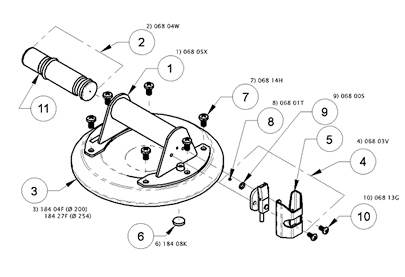 |
Its Ø 200 natural rubber sole offers it the following performance characteristics on a smooth and clean surface:
|
Direction of pull |
Average lifting force (kg) |
Holding capacity for load (kg) |
|
- |
100 |
|
180 |
50 |
For all these suction lifters, the lifting force is measured parallel to the surface carried (the weakest value). The capacity is always expressed as a traction force perpendicular to the surface: divide by 2 for traction parallel to the surface.
|
|
|
|
| 18402C : ABS handle and frame, ergonomic, lightweight, and reliable (average measurement: 160 kg) – capacity 100 kg. |
18417U : sole dia. 254 - capacity 140 kg(average measurement: 335 kg) for curved surfaces R>330 mm
(caution with thin thicknesses).
|
18443X : special anti-release sole and blue plunger for "low pressure" or "high altitude" (up to 3650 m) - capacity 80 kg. |
18452H : sole dia. 153 - capacity 65 kg. Ideal for curved surfaces R>305 mm, such as automotive glass. |
VERTICAL HANDLING SUCTION CUP LIFTERS LEVERED CUPS
|
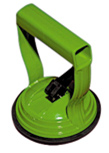 |
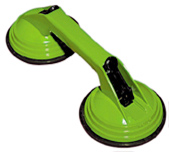 |
|
|
|
|
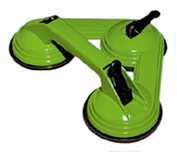 |
Suction cup lifters in cast aluminium structure, équiped with rubber suction cups diam. 120 mm. Immediate release, no residual grip at pulling down lever.
High performance at pulling up. |
|
|
18438S
Repair pouch for suction cup lifter |
|
|
|
|
Suction cup lifter RELDA® fitted with rubber levered cup, dia. 100 mm, steel structure, 2 cups, load: 60 kg, weight: 720 g
|
Repair pouch : with dia. 100 mm cup, llever and axle.
. |
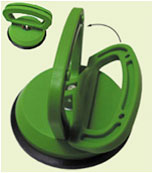 |
|
Hand-held vacuum cup lifter. Handle specially designed for one-hand use. Suitable to all smooth and non-porous surfaces.
Suction cup Ø: 120 mm.
Max. load: 40 kg.
Ideal for horizontal handling of glass on a table or conveyor. |
HORIZONTAL HANDLING OF GLASS OR CONVEYOR
Suction cups dia. 85mm, in polyesterurethane (oil resistant), very light.
|
18426D:
Suction lifter FUTURA®; one cup in polyurethan (oil resistant); cast aluminium handle, load 35 kg, dia. 85 mm, weight 75 g |
|
18423A:
Suction lifter FUTURA®; two cups, release by pushing knob (ADLER S.A. Patent); frame in A.B.S., cups in polyurethan (oil resistant); handle specially designed to facilitate horizontal and vertical transport, load 55 kg, dia. 85 mm, weight 450 g
. |
|
|
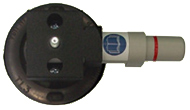 |
18450F
Dia. 77mm
Minimum curvature radius > 102
Load max 7kg |
18411N
Suction cup for hanging objects; rubber cup. Steel, dia. 100 mm, weight: 300 g |
|
18413Q
white rubber cup.
Dia. 30 mm, with hook |
18441V
Plastic cup.
Dia. 60 mm |
|
18451G
Dia. 115mm
Minimum curvature radius >305mm
Load max 18kg |
(currently under review in compliance with the latest version for the machinery Directive 2006/42/EC)
Comment regarding the safety of suction lifters:
The items of product group 184 are not lifting equipment but manual accessories: they must by no means be placed between a machine and a load being lifted. Their use shall be limited to that of a manual transport handle.
They are thus excluded from the EC regulatory framework regarding machinery (Directive 98/37/EC), and therefore not subject to CE marking requirements.
Consult the catalogue to know the maximum loads per reference and how to interpret these values. When transporting plates vertically (in the case of glass) the loads indicated must be divided by two.
Compliance and marking:
Some clients require a certificate of compliance and CE marking for the suction lifters of product group 184. They base their request on European machinery regulations (Directive 98/37/EC) reiterated in the form of articles R233 in the labour code.
After consulting the INRS, we again have reached the conclusion that these requirements are unfounded and result from a misinterpretation of the texts.
Purely regulatory aspects:
1) CE marking of a product only makes sense within the scope of Directive 98/37/EC as described in Article 1 and reiterated in Article R233-83 of the labour code.
2) The items of product group 184 are not lifting accessories within the meaning of Article R233-83 §3, unlike, for example, a lifting beam or lifting clamps, as they are not intended to be placed between a machine and a load.
3) A suction lifter can be considered as a machine within the meaning of Article 1 - Paragraph 2 of Directive 98/37/EC. Indeed, it is a set of parts linked together, at least one of which is mobile (lever, plunger).
4) Article 1 - Paragraph 3, states: "The following shall be excluded from the scope of this Directive: - machinery whose only power source is directly applied manual effort, unless it is a machine used for lifting or lowering loads, ». One might then think that lifters are not excluded since they are used for lifting... However, the official comments of the CE regarding this item offer a different interpretation: a suction lifter is a machine having 2 functions:
a) To secure a handle to a load by means of a mechanism creating a vacuum inside a suction cup and manually actuated. The action of the mechanism stops as soon as the application of human force stops (see comment 87) and no dangerous action can occur after the human action has stopped (see comment 88).
b) To lift a load under human action, but there is no specific risk as soon as human action ceases, unlike , for example jacks, lifting beams and hand winches which allow a load to be held at height after human action has ceased and thus presents a danger (see comment 89).
Other aspects:
1) We could self-certify ourselves and affix CE marking to our suction lifters, thereby satisfying the requests of our customers. The INRS advises not to adopt this solely commercial-based policy, as it would only contribute to obscuring the scope of Directive 98/37/EC.
2) In any case, this wouldn't make sense as there are currently no technical prescriptions concerning this product.

Z.A. La Barogne - 9, Av des 22 Arpents - 77230 Moussy le Neuf - France
Tél.: +33 (0)1.60.03.62.00 - Fax : +33 (0)1.60.03.62.49
E-mail : admin1@adler-sa.com - Site : www.adler-sa.fr
SAS au capital de 2 014 000 euros . RCS Meaux |
